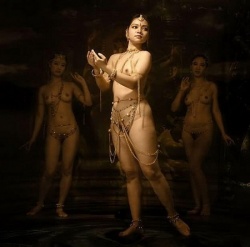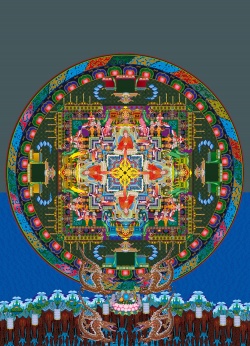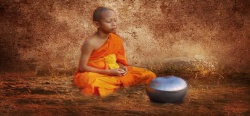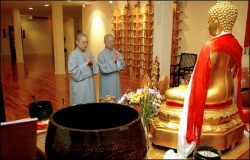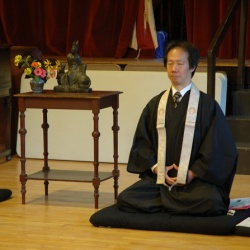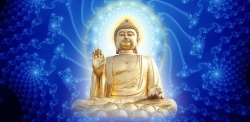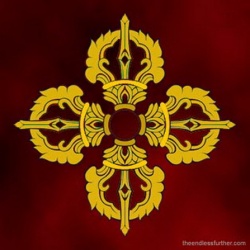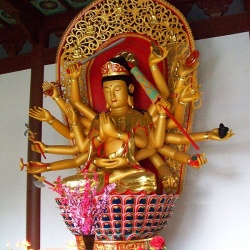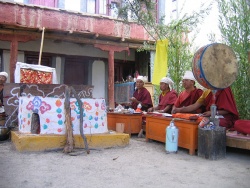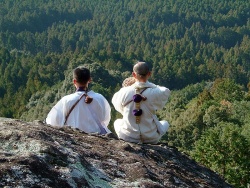Vajrayana
Vajrayana (Devanagari: वज्रयान; Oriya: ବଜ୍ରଯାନ, Tibetan: རྡོ་རྗེ་ཐེག་པ་, rdo rje theg pa; Mongolian: Очирт хөлгөн, Ochirt Hölgön, Chinese: 密宗, mì zōng) is also known as Tantric Buddhism, Tantrayāna, Mantrayāna, Secret Mantra, Esoteric Buddhism and the Diamond Vehicle. Vajrayana is a complex and multifaceted system of Buddhist thought and practice which evolved over several centuries.
According to Vajrayana scriptures Vajrayana refers to one of three vehicles or routes to enlightenment, the other two being the Theravada and Mahayana.
Founded by the Indian Mahasiddhas, Vajrayana subscribes to Buddhist tantric literature.
History of Vajrayana
Although the first tantric Buddhist texts appeared in India in the 3rd century and continued to appear until the 12th century, scholars such as Hirakawa Akira assert that the Vajrayana probably came into existence in the 6th or 7th century, while the term Vajrayana itself first appeared in the 8th century. The Vajrayana was preceded by the Mantrayana, and then followed by the Sahajayana and Kalachakrayana.
India
The period of Indian Vajrayana Buddhism has been classified as the fifth or final period of Indian Buddhism.
Historical origins
Mantrayana and Vajrayana
Although the Vajrayana claims to be as ancient and authentic as any other Buddhist school, it may have grown up gradually in an environment with previously existing texts such as the mahasannipata and the ratnaketudharani. The basic position of Vajrayana is still the same as the early Buddhist position of not-self: there is nothing which is eternal. The changes that took place reflected the changing society of medieval India: the presentation changed, the techniques of the way to enlightenment changed, and the outward appearance of Buddhism came to be dominated by ritualism, and the array of Buddhas, Bodhisattvas, and gods and goddesses.
There are differing views as to where in the Indian sub-continent that Vajrayana began. There are assumptions about the origin of Vajrayana in Bengal, Uddiyana, located at Orissa, or in the modern day Swat Valley in Pakistan.
The earliest texts appeared around the early 4th century. Nalanda University in eastern India became a center for the development of Vajrayana theory, although it is likely that the university followed, rather than led, the early Tantric movement.
Only from the 7th or the beginning of the 8th century, tantric techniques and approaches increasingly dominated Buddhist practice in India. From the 7th century onwards many popular religious elements of a heterogeneous nature were incorporated into Mahayana Buddhism, which finally resulted in the appearance of Vajrayana, Kalachakrayana, and Sahajayana Tantric Buddhism. These new Tantric cults of Buddhism introduced Mantra, Mudra and Mandala, along with six tantric Abhicharas (practices) such as Marana (Death), Stambhana, Sammohana, Vidvesan, Uchchatana and Vajikarana. These cults revived primitive beliefs and practices, a simpler and less formal approach to the personal god, a liberal and respectful attitude towards women, and denial of the caste system.
India would continue as the source of leading-edge Vajrayana practices up until the 11th century, producing many renowned Mahasiddha.
(Vajrayana Buddhism had mostly died out in India by the 13th century, and tantric versions of Buddhism and Hinduism were also experiencing pressure from invading Islamic armies. By that time, the vast majority of the practices were also manifest in Tibet, where they were preserved until recently.
In the second half of the 20th century a sizable number of Tibetan exiles fled the oppressive, anti-religious rule of the Communist Chinese to establish Tibetan Buddhist communities in northern India, particularly around Dharamsala.
Sahajayana and Kalachakrayana
The Vajrayana established the symbolic terminology and the liturgy that would characterize all forms of the tradition.
The Sahajayana developed in the 8th century in Bengal. It was dominated by long-haired, wandering siddhas who openly challenged and ridiculed the Buddhist establishment. Its most important text is the Dohakosa, written by Sarahapada.
The Kalachakrayana developed in the 10th century. It is farthest removed from the earlier Buddhist traditions, and incorporates concepts of messianism and astrology not present elsewhere in Buddhist literature.
Despised classes
The Tantric Buddhist sects made efforts to raise the dignity of the lowest of the low of the society to a higher level. Many celebrated Vajrayana Acharyas like Saraha, Hadipa, Dombi, Heruka, Tantipa (Tantripāda) and Luipāda came from the so-called despised classes.
The cult exerted a tremendous influence over the tribal and despised classes of people of Sambalpur and Bolangir region.
In the 9th or 10th century seven famous Tantric maidens appeared in the Patna (Patnagarh) region, which was then called Kuānri-Pātaṇā. These maidens are popularly known as Sāta Bhauni (seven sisters), namely, Gyanadei Maluni, Luhakuti, Luhuruṇi,Nitei Dhobani, Sukuti Chamaruṇi, Patrapindhi Sabaruṇi, Gangi Gauduṇi and sua Teluṇi. They hailed from the castes which were considered the lower castes of society, and were followers of Lakshminkara. Because of their miraculous power and feats, they were later deified and worshiped by the locals.
China
Esoteric teachings followed the same route into northern China as Buddhism itself, arriving via the Silk Road sometime during the first half of the 7th century, during the Tang Dynasty. Esoteric Mantrayana practices arrived from India just as Buddhism was reaching its zenith in China, and received sanction from the emperors of the Tang Dynasty. During this time, three great masters came from India to China: Śubhakarasiṃha, Vajrabodhi, and Amoghavajra. These three masters brought the esoteric teachings to their height of popularity in China. During this era, the two main source texts were the Mahāvairocana Abhisaṃbodhi Tantra, and the Tattvasaṃgraha Tantra. Traditions in the Sinosphere still exist for these teachings, and they more or less share the same doctrines as Shingon, with many of its students themselves traveling to Japan to be given transmission at Mount Koya.
Esoteric methods were naturally incorporated into Chinese Buddhism during the Tang Dynasty. Śubhakarasiṃha's most eminent disciple, Master Yixing (Ch. 一行), was a member of the Zen school. In such a way, in Chinese Buddhism there was no major distinction between exoteric and esoteric practices, and the northern school of Zen Buddhism even became known for its esoteric practices of dhāraṇīs and mantras.
During the Yuan Dynasty, the Mongol emperors made Esoteric Buddhism the official religion of China, and Tibetan lamas were given patronage at the court. A common perception was that this patronage of lamas caused corrupt forms of tantra to become widespread. When the Mongol Yuan Dynasty was overthrown and the Ming Dynasty was established, the Tibetan lamas were expelled from the court, and this form of Buddhism was denounced as not being an orthodox path.
In late imperial China, the early traditions of Esoteric Buddhism were still thriving in Buddhist communities. Robert Gimello has also observed that in these communities, the esoteric practices associated with Cundī were extremely popular among both the populace and the elite.
Tibet and other Himalayan kingdoms
In 747 the Indian master Padmasambhava traveled from Afghanistan to bring Vajrayana Buddhism to Tibet and Bhutan, at the request of the king of Tibet. This was the original transmission which anchors the lineage of the Nyingma school. During the 11th century and early 12th century a second important transmission occurred with the lineages of Atisa, Marpa and Brogmi, giving rise to the other schools of Tibetan Buddhism, namely Kadam, Kagyu, Sakya, and Geluk (the school of the Dalai Lama).
Japan
During the Tang Dynasty in China, when esoteric Buddhist practices reached their peak, Japan was actively importing Buddhism, its texts and teachings, by sending monks on risky missions across the sea to stay in China for two years or more. Depending on where the monk stayed and trained, they may have brought back esoteric Buddhist material and training back to Japan.
In 804, monk Saicho came back from China with teachings from the Tiantai sect, but was also trained in esoteric lineages. When he later founded the Japanese Tendai sect, esoteric practices were integrated with the Tendai teachings, but Tendai is not an exclusively esoteric sect. Subsequent disciples of Saicho also returned from China in later years with further esoteric training, which helped to flesh out the lineage in Japan.
On the same mission in 804, Emperor Kammu also sent monk Kūkai to the Tang Dynasty capital at Chang'an (present-day Xi'an). Kūkai absorbed the Vajrayana thinking from eminent Indian and Chinese Vajrayana teachers at the time, and synthesized a version of which he took back with him to Japan, where he founded the Shingon school of Buddhism, a school which continues to this day. Unlike Tendai, Shingon is a purely esoteric sect.
Indonesian Archipelago
The empire of Srivijaya in southeast Sumatra was already a center of Vajrayana learning when Dharma Master Yijing (Ch. 法師義淨) resided there for six months in 671, long before Padmasambhava brought the method to Tibet. In the 11th century, Atisha studied in Srivijaya under Serlingpa, an eminent Buddhist scholar and a prince of the Srivijayan ruling house.
Through early economic relationships with the Srivijaya Empire, the Philippines came under the influence of Vajrayana. Vajrayana Buddhism also influenced the construction of Borobudur, a three-dimensional mandala, in central Java circa 800.
[[Image:Young Monk in Shalu Monastery Shigatse Tibet Luca Galuzzi 2006.jpg|thumb|250px|Young Monk in Shalu Monastery, Shigatse, Tibet]]
Mongolia
In the 13th century, the Tibetan Buddhist teachers of the Sakya school led by Sakya Pandita Kunga Gyaltsen, took part in a religious debate with Christians and Muslims before the Mongolian royal court. As a result the Mongolian Prince Godan adopted Tibetan Buddhism as his personal religion, although not requiring it of his subjects. Drogön Chögyal Phagpa, Kagyupa Pandita's nephew, eventually converted Kublai Khan to Buddhism.
Since the Khan conquered China and established the Yuan Dynasty which lasted from 1271 to 1368, this led to the renewal in China of the Tantric practices which had died out there many years earlier. Vajrayana practice declined in China and Mongolia with the fall of the Yuan Dynasty. Mongolia saw another revival of Vajrayana in the 17th century, with the establishment of ties between the Dalai Lama in Tibet and the Mongolian princedoms. This revived the historic pattern of the spiritual leaders of Tibet acting as priests to the rulers of the Mongol empire. Having survived suppression by the Communists, Buddhism in Mongolia is today primarily of the Gelugpa school of Tibetan Buddhism, and is being re-invigorated following the fall of the Communist government.
Place within Buddhist tradition
Various classifications are possible when distinguishing Vajrayana from the other Buddhist traditions. Third turning of the wheel
Vajrayana can also be seen as the third of the three "turnings of the wheel of dharma":
- In the first turning Shakyamuni Buddha taught the Four Noble Truths at Varanasi in the 5th century BC, which led to the founding of Buddhism and the later early Buddhist schools. Details of the first turning are described in the Dhammacakkapavattana Sutta. The oldest scriptures do not mention any further turnings other than this first turning.
- The Mahayana tradition claims that there was a second turning in which the Perfection of Wisdom sutras were taught at Vulture's Peak, which led to the Mahayana schools. Generally, scholars conclude that the Mahayana scriptures (including the Perfection of Wisdom Sutras) were composed from the 1st century CE onwards.
- According to the Vajrayana tradition, there was a third turning which took place at Dhanyakataka sixteen years after the Buddha's enlightenment. Some scholars have strongly denied that Vajrayana appeared at that time, and placed it at a much later time. The first tantric (Vajrayana Buddhist) texts appeared in the 3rd century CE, and they continued to appear until the 12th century.
Sutrayana and Vajrayana
Vajrayana can be distinguished from the Sutrayana. The Sutrayana is the method of perfecting good qualities, where the Vajrayāna is the method of taking the intended outcome of Buddhahood as the path.
Paramitayana and Vajrayana
According to this schema, Indian Mahayana revealed two vehicles (yana) or methods for attaining enlightenment: the method of the perfections (Paramitayana) and the method of mantra (Mantrayana).
The Paramitayana consists of the six or ten paramitas, of which the scriptures say that it takes three incalculable aeons to lead one to Buddhahood. The tantra literature, however, claims that the Mantrayana leads one to Buddhahood in a single lifetime. According to the literature, the mantra is an easy path without the difficulties innate to the Paramitanaya. Mantrayana is sometimes portrayed as a method for those of inferior abilities. However the practitioner of the mantra still has to adhere to the vows of the Bodhisattva.
Philosophical background
Vajrayana is firmly grounded in Mahayana-philosophy, especially Madhyamaka.
Two Truths Doctrine
Vajrayana subscribes to the two truths doctrine of conventional and ultimate truths, which is present in all Buddhist tenet systems. The two truths doctrine is a central concept in the Vajrayana path of practice and is the philosophical basis for its methods. The two truths identifies conventional a.k.a. relative, and absolute a.k.a. nirvana. Conventional truth is the truth of consensus reality, common-sense notions of what does and does not exist. Ultimate truth is reality as viewed by an awakened, or enlightened mind.
Characteristics of Vajrayana
Goal
The goal of spiritual practice within the Mahayana and Vajrayana traditions is to become a Buddha as fast as possible for the benefit of all sentient beings. Such an aspiration makes one a Bodhisattva.
In the Sutrayana practice, a path of Mahayana, the "path of the cause" is taken, whereby a practitioner starts with his or her potential Buddha-nature and nurtures it to produce the fruit of Buddhahood. In the Vajrayana the "path of the fruit" is taken whereby the practitioner takes his or her innate Buddha-nature as the means of practice. The premise is that since we innately have an enlightened mind, practicing seeing the world in terms of ultimate truth can help us to attain our full Buddha-nature.
Experiencing ultimate truth is said to be the purpose of all the various tantric techniques practiced in the Vajrayana. Apart from the advanced meditation practices such as Mahamudra and Dzogchen, which aim to experience the empty nature of the enlightened mind that can see ultimate truth, all practices are aimed in some way at purifying the impure perception of the practitioner to allow ultimate truth to be seen. These may be ngondro, or preliminary practices, or the more advanced techniques of the tantric sadhana.
Motivation
As with the Mahayana, motivation is a vital component of Vajrayana practice. The Bodhisattva motivation is an integral part of the Vajrayana. All practices are to be undertaken with the motivation to achieve Buddhahood as fast as possible so that one may benefit of all sentient beings.
Ritual
The distinctive feature of Vajrayana Buddhism is ritual, which is used as a substitute or alternative for the earlier abstract meditations. For Vajrayana Tibetan death rituals, see phowa.
Upaya
The Vajrayana is based on the concept of "skilful means" (Sanskrit: upaya) as formulated in Mahayana Buddhism. It is a system of lineages, whereby those who successfully receive an Empowerment (Tibetan Buddhism) or sometimes called initiation (permission to practice) are seen to share in the mindstream of the realisation of a particular skillful means of the vajra Master. In the Vajrayana these skilful means mainly relate to tantric, Mahamudra or Dzogchen practices. Vajrayana teaches that the Vajrayana techniques provide an accelerated path to enlightenment.
Esoteric transmission
- See also:Esoteric transmission
Vajrayana Buddhism is esoteric, in the sense that the transmission of certain teachings only occurs directly from teacher to student during an initiation or empowerment and cannot be simply learned from a book. Many techniques are also commonly said to be secret, but some Vajrayana teachers have responded that secrecy itself is not important and only a side-effect of the reality that the techniques have no validity outside the teacher-student lineage. In order to engage in Vajrayana practice, a student should have received such an initiation or permission:
- If these techniques are not practiced properly, practitioners may harm themselves physically and mentally. In order to avoid these dangers, the practice is kept "secret" outside the teacher/student relationship. Secrecy and the commitment of the student to the vajra guru are aspects of the samaya (Tib. damtsig), or "sacred bond", that protects both the practitioner and the integrity of the teachings."
The teachings may also be considered "self-secret", meaning that even if they were to be told directly to a person, that person would not necessarily understand the teachings without proper context. In this way the teachings are "secret" to the minds of those who are not following the path with more than a simple sense of curiosity.
Vows and behaviour
Practitioners of the Vajrayana need to abide by various tantric vows or samaya of behaviour. These are extensions of the rules of the Pratimoksha vows and Bodhisattva vows for the lower levels of tantra, and are taken during initiations into the empowerment for a particular Anuttarayoga tantra. The special tantric vows vary depending on the specific mandala practice for which the initiation is received, and also depending on the level of initiation.
The Ngagpa/Ngakmo Yogis from the Nyingma school keep a special non-celibate ordination, they are practitioners and are considered neither lay nor monk or nun.
A tantric guru, or teacher, is expected to keep his or her samaya vows in the same way as his students. Proper conduct is considered especially necessary for a qualified Vajrayana guru. For example, the Ornament for the Essence of Manjushrikirti states:
- Distance yourself from Vajra Masters who are not keeping the three vows
- who keep on with a root downfall, who are miserly with the Dharma,
- and who engage in actions that should be forsaken.
- Those who worship them go to hell and so on as a result.
Tantra techniques
Classifications of tantra
The various Tantra-texts can be classified in various ways.
Fourfold division
The best-known classification is by the Gelug, Sakya, and Kagyu schools, the so-called Sarma or New Translation schools of Tibetan Buddhism. They divide the Tantras into four hierarchical categories:
- Kriyayoga, action tantra, which emphasizes ritual;
- Charyayoga, performance tantra, which emphasizes meditation;
- Yogatantra, yoga tantra;
- Anuttarayogatantra, highest yoga tantra, which is further divided into "mother", "father" and "non-dual" tantras.
Outer and Inner Tantras
A different division is used by the Nyingma or Ancient Translation school. Kriyayoga, Charyayoga and Yogatantra are called the Outer Tantras, while Anuttarayogatantra is divided into Three Inner Tantras, which correspond to the
- Mahayoga
- Anuyoga
- Atiyoga, or Dzogchen. The practice of Atiyoga is further divided into three classes: Mental SemDe, Spatial LongDe, and Esoteric Instructional MenNgagDe.
Annuttara-yoga tantras
In the highest class of tantra, two stages of practice are distinguished. Details of these practices are normally only explained to practitioners by their teachers after receiving an initiation or 'permission to practice'.
In some Buddhist tantras, both stages can be practiced simultaneously, whereas in others, one first actualizes the generation stage before continuing with the completion stage practices.
Generation stage
In the first stage of generation, one engages in deity yoga. One practices oneself in the identification with the meditational Buddha or deity (yidam) by visualisations, until one can meditate single-pointedly on 'being' the deity.
Four purities
In the generation stage of Deity Yoga, the practitioner visualizes the "Four Purities" (Tibetan: yongs su dag pa bzhi; yongs dag bzhi) which define the principal Tantric methodology of Deity Yoga that distinguishes it from the rest of Buddhism:
- Seeing one's body as the body of the deity
- Seeing one's environment as the pure land or mandala of the deity
- Perceiving one's enjoyments as bliss of the deity, free from attachment
- Performing one's actions only for the benefit of others (bodhichitta motivation, altruism)
Completion stage
In the next stage of completion, the practitioner can use either the path of method (thabs lam) or the path of liberation ('grol lam).
At the path of method the practitioner engages in Kundalini yoga practices. These involve the subtle energy system of the body of the chakras and the energy channels. The "wind energy" is directed and dissolved into the heart chakra, where-after the Mahamudra remains, and the practitioner is physically and mentally transformed.
At the path of liberation the practitioner applies mindfulness, a preparatory practice for Mahamudra or Dzogchen, to realize the inherent emptiness of every-'thing' that exists.
Deity yoga
Deity yoga (Tibetan: lha'i rnal 'byor; Sanskrit: Devata) is the fundamental Vajrayana practice. It is a sadhana in which practitioners visualize themselves as a deity or yidam. Deity Yoga brings the meditator to the experience of being one with the deity:
- Deity Yoga employs highly refined techniques of creative imagination, visualisation, and photism in order to self-identify with the divine form and qualities of a particular deity as the union of method or skilful means and wisdom. As His Holiness the Dalai Lama says, "In brief, the body of a Buddha is attained through meditating on it".
By visualizing oneself and one's environment entirely as a projection of mind, it helps the practitioner to become familiar with the mind's ability and habit of projecting conceptual layers over all experience. This experience undermines a habitual belief that views of reality and self are solid and fixed. Deity yoga enables the practitioner to release, or 'purify' him or herself from spiritual obscurations (Sanskrit: klesha) and to practice compassion and wisdom simultaneously.
Recent studies indicate that Deity yoga yields quantifiable improvements in the practitioner's ability to process visuospatial information, specifically those involved in working visuospatial memory.
Guru yoga
Guru yoga (or teacher practice) (Tibetan: bla ma'i rnal 'byor) is a tantric devotional process whereby the practitioners unite their mindstream with the mindstream of the guru.
The guru is engaged as yidam, as a nirmanakaya manifestation of a Buddha. The process of guru yoga might entail visualization of an entire lineage of masters (refuge tree) as an invocation of the lineage. It usually involves visualization of the guru above or in front of the practitioner. Guru yoga may entail a liturgy or mantra such as the Prayer in Seven Lines. (Tibetan: tshig bdun gsol 'debs)
The Guru or spiritual teacher is essential as a guide during tantric practice, as without their example, blessings and grace, genuine progress is held to be impossible for all but the most keen and gifted. Many tantric texts qualify the Three Jewels of Buddha, Dharma and Sangha thus: "The Guru is Buddha, the Guru is Dharma, the Guru is also Sangha" to reflect their importance for the disciple. The guru is considered even more compassionate and more potent than the Buddha because we can have a direct relationship with the guru. The guru therefore appears with the yidam and dakini in the Three Roots refuge formulation of the three factors essential for tantric attainments.
Death yoga
According to the Vajrayana tradition, at certain times the body-mind is in a very subtle state which can be used by advanced practitioners to transform the mindstream. Such liminal times are known in Tibetan Buddhism as Bardo states and include such transitional states as during meditation, dreaming, sex and death.
Death yoga, or "bringing the three bodies into the path of death, intermediate state (bardo) and rebirth", helps to prepare the practitioner for what they need to do at the time of death. Although it is sometimes called "death yoga," it is mainly practiced during life, in meditation. It can be practiced first according to generation stage, and then according to completion stage. The accumulation of meditative practice helps to prepare the practitioner for what they need to do at the time of death.
At the time of death the mind is in a subtle state (clear light) that can open the mind to enlightenment if it is skilfully used to meditate on emptiness (shunyata). During completion stage meditation it is possible to manifest a similar clear light mind and to use it to meditate on emptiness. This meditation causes dualistic appearances to subside into emptiness and enables the practitioner to destroy their ignorance and the imprints of ignorance that are the obstructions to omniscience. It is said that masters like Lama Tsong Khapa used these techniques to achieve enlightenment during the death process. Actually, there are three stages at which it is possible to do this: at the end of the death process, during the bardo (or 'in between period') and during the process of rebirth. During these stages, the mind is in a very subtle state, and an advanced practitioner can use these natural states to make significant progress on the spiritual path. The Tibetan Book of the Dead is an important commentary for this kind of traditional practice.
This death yoga should not be confused with the non-Tantric meditation on impermanence and death, which is a common practice within Buddhist traditions used to overcome desirous attachment.
Another Tibetan ritual practice related to death is phowa (transference of one's consciousness), which can be done by oneself at the moment of death or by ritual specialists, phowa-lamas, on behalf of the dead. For the Anuttarayoga Tantras (Tib. rnal-’byor bla-med-kyi-rgyud), transferring one’s consciousness constitutes one of the two ways to separate the coarse and subtle bodies through meditation. Daniel Cozort explains that ’pho-ba (phowa) merely separates the coarse and subtle bodies without leading to the attainment of an “illusory body” (Tib. sgyu-lus). On the other hand, during the perfection type meditation, known as the “final mental isolation” (Tibetan: sems-dben) because it necessitates the presence of an “actual consort” (Tib. las-rgya), “the winds are totally dissolved in the indestructible drop”, and “the fundamental wind naturally rises into an illusory body”.
Symbols and imagery
The Vajrayana uses a rich variety of symbols and images.
The Vajra
The Sanskrit term "vajra" denoted the thunderbolt, a legendary weapon and divine attribute that was made from an adamantine, or indestructible, substance and which could therefore pierce and penetrate any obstacle or obfuscation. It is the weapon of choice of Indra, the King of the Devas in Hinduism. As a secondary meaning, "vajra" refers to this indestructible substance, and so is sometimes translated as "adamantine" or "diamond". So the Vajrayana is sometimes rendered in English as "The Adamantine Vehicle" or "The Diamond Vehicle".
A vajra is also a scepter-like ritual object (Standard Tibetan: རྡོ་རྗེ་ dorje), which has a sphere (and sometimes a gankyil) at its centre, and a variable number of spokes, 3, 5 or 9 at each end (depending on the sadhana), enfolding either end of the rod. The vajra is often traditionally employed in tantric rituals in combination with the bell or ghanta; symbolically, the vajra may represent method as well as great bliss and the bell stands for wisdom, specifically the wisdom realizing emptiness.
Imagery and ritual in deity yoga

Representations of the deity, such as a statues (murti), paintings (thangka), or mandala, are often employed as an aid to visualization, in Deity yoga. Mandalas are sacred enclosures, sacred architecture that house and contain the uncontainable essence of a yidam. In the book The World of Tibetan Buddhism, the Dalai Lama describes mandalas thus: "This is the celestial mansion, the pure residence of the deity."
All ritual in Vajrayana practice can be seen as aiding in this process of visualization and identification. The practitioner can use various hand implements such as a vajra, bell, hand-drum (damaru) or a ritual dagger (phurba), but also ritual hand gestures (mudras) can be made, special chanting techniques can be used, and in elaborate offering rituals or initiations, many more ritual implements and tools are used, each with an elaborate symbolic meaning to create a special environment for practice. Vajrayana has thus become a major inspiration in traditional Tibetan art.
Vajrayana textual tradition
The Vajrayana tradition has dedeveloped an extended body of texts:
- Though we do not know precisely at present just how many Indian tantric Buddhist texts survive today in the language in which they were written, their number is certainly over one thousand five hundred; I suspect indeed over two thousand. A large part of this body of texts has also been translated into Tibetan, and a smaller part into Chinese. Aside from these, there are perhaps another two thousand or more works that are known today only from such translations. We can be certain as well that many others are lost to us forever, in whatever form. Of the texts that survive a very small proportion has been published; an almost insignificant percentage has been edited or translated reliably."
Schools of Vajrayana
Although there is historical evidence for Vajrayana Buddhism in Southeast Asia and elsewhere (see History of Vajrayana below), today the Vajrayana exists primarily in the form of the two major sub-schools of Tibetan Buddhism and Esoteric Buddhism in Japan known as Shingon, with a handful of minor subschools utilising lesser amounts of esoteric or tantric materials.
The distinction between traditions is not always rigid. For example, the tantra sections of the Tibetan Buddhist canon of texts sometimes include material not usually thought of as tantric outside the Tibetan Buddhist tradition, such as the Heart Sutra and even versions of some material found in the Pali Canon.
Tibetan Buddhism
The Tibetan Buddhist schools, based on the lineages and textual traditions of the Kangyur and Tengyur of Tibet, are found in Tibet, Bhutan, northern India, Nepal, southwestern and northern China, Mongolia and various constituent republics of Russia that are adjacent to the area, such as Amur Oblast, Buryatia, Chita Oblast, the Tuva Republic and Khabarovsk Krai. Tibetan Buddhism is also the main religion in Kalmykia.
Vajrayana Buddhism was established in Tibet in the 8th century when Śāntarakṣita was brought to Tibet from India at the instigation of the Dharma King Trisong Detsen, some time before 767. He established the basis of what later came to be known as the Nyingma school. As a Tantric Mahasiddha Padmasambhava's contribution ensured that Vajrayana became part of Tibetan Buddhism. While Vajrayana Buddhism is a part of Tibetan Buddhism in that it forms a core part of every major Tibetan Buddhist school, it is not identical with it. Buddhist scholar Alexander Berzin refers to "the Mahayana and Vajrayana traditions of Tibetan Buddhism". Training in the "common paths" of Sutra (including Lamrim) are said to be the foundation for the "uncommon path" of Vajrayana. The Vajrayana techniques add 'skillful means' to the general Mahayana teachings for advanced students. The 'skillful means' of the Vajrayana in Tibetan Buddhism refers to tantra techniques, Dzogchen (Tibetan; Sanskrit:maha-ati) and Mahamudra (Tibetan:Chagchen).
Nepalese Newar Buddhism
Newar Buddhism is practiced by Newars in Nepal. This is the only form of Vajrayana Buddhism in which the scriptures are written in Sanskrit. Its priests do not follow celibacy and are called Vajracharyas.
Ari Buddhism
Ari Buddhism was common in Burma, prior to Anawrahta's rise and the subsequent conversion to Theravada Buddhism in the 11th century.
Chinese Esoteric Buddhism
Esoteric traditions in China are similar in teachings to the Japanese Shingon school, though the number of practitioners was greatly reduced, due in part of the persecution of Buddhists under Emperor Wuzong of Tang, nearly wiping out most of the Chinese Esoteric Buddhist lineage. In China and countries with large Chinese populations such as Taiwan, Malaysia and Singapore, Chinese Esoteric Buddhism is commonly referred as Tángmì (唐密) "Tang Dynasty Secret Buddhism," or Hànchuánmìzōng (漢傳密宗) "Secret Buddhism of the Han Transmission" (Hànmì 漢密 for short), or Dōngmì (東密) "Eastern Secret Buddhism." In a more general sense, the Chinese term Mìzōng (密宗) "The Secret Way", is the most popular term used when referring to any form of Esoteric Buddhism. These traditions more or less share the same doctrines as the Shingon school, with many of its students themselves traveling to Japan to be given transmission at Mount Koya.
According to Master Hsuan Hua, the most popular example of esoteric teachings still practiced in many Zen monasteries of East Asia, is the Śūraṅgama Sūtra and its dhāraṇī (Sitātapatroṣṇīṣa Dhāraṇī), along with the Great Compassion Dharani (Nīlakaṇṭha Dhāranī), with its 42 Hands and Eyes Mantras.

Japan
Shingon Buddhism
The Shingon school is found in Japan and includes practices, known in Japan as Mikkyō, which are similar in concept to those in Vajrayana Buddhism. The lineage for Shingon Buddhism differs from that of Tibetan Vajrayana, having emerged from India during the 9th-11th centuries in the Pala Dynasty and Central Asia (via China) and is based on earlier versions of the Indian texts than the Tibetan lineage. Shingon shares material with Tibetan Buddhism–-such as the esoteric sutras (called Tantras in Tibetan Buddhism) and mandalas – but the actual practices are not related. The primary texts of Shingon Buddhism are the Mahavairocana Sutra and Vajrasekhara Sutra. The founder of Shingon Buddhism was Kukai, a Japanese monk who studied in China in the 9th century during the Tang Dynasty and brought back Vajrayana scriptures, techniques and mandalas then popular in China. The school mostly died out or was merged into other schools in China towards the end of the Tang Dynasty but flourished in Japan. Shingon is one of the few remaining branches of Buddhism in the world that continues to use the siddham script of the Sanskrit language.
Tendai Buddhism
Although the Tendai school in China and Japan does employ some esoteric practices, these rituals came to be considered of equal importance with the exoteric teachings of the Lotus Sutra. By chanting mantras, maintaining mudras, or practicing certain forms of meditation, Tendai maintains that one is able to understand sense experiences as taught by the Buddha, have faith that one is innately an enlightened being, and that one can attain enlightenment within the current lifetime.
Shugendō
Shugendō was founded in 7th century Japan by the ascetic En no Gyōja, based on the Queen's Peacocks Sutra. With its origins in the solitary hijiri back in the 7th century, Shugendō evolved as a sort of amalgamation between Esoteric Buddhism, Shinto and several other religious influences including Taoism. Buddhism and Shinto were amalgamated in the shinbutsu shūgō, and Kūkai's syncretic view held wide sway up until the end of the Edo period, coexisting with Shinto elements within Shugendō
In 1613 during the Edo period, the Tokugawa Shogunate issued a regulation obliging Shugendō temples to belong to either Shingon or Tendai temples. During the Meiji Restoration, when Shinto was declared an independent state religion separate from Buddhism, Shugendō was banned as a superstition not fit for a new, enlightened Japan. Some Shugendō temples converted themselves into various officially approved Shintō denominations. In modern times, Shugendō is practiced mainly by Tendai and Shingon sects, retaining an influence on modern Japanese religion and culture.
Literary characteristics
Vajrayana texts exhibit a wide range of literary characteristics—usually a mix of verse and prose, almost always in a Sanskrit that "transgresses frequently against classical norms of grammar and usage," although also occasionally in various Middle Indic dialects or elegant classical Sanskrit.
Dunhuang manuscripts
The Dunhuang also contains Tibetan Tantric manuscripts. Dalton and Schaik (2007, revised) provide an excellent online catalogue listing 350 Tibetan Tantric Manuscripts] from Dunhuang in the Stein Collection of the British Library which is currently fully accessible online in discrete digitized manuscripts. With the Wylie transcription of the manuscripts they are to be made discoverable online in future. The 350 texts is just a small number compared to the vast cache of the Dunhuang manuscripts.
Academic study difficulties
Serious Vajrayana academic study in the Western world is in early stages due to the following obstacles:
- Although a large number of Tantric scriptures are extant, they have not been formally ordered or systematized.
- Due to the Esoteric initiatory nature of the tradition, many practitioners will not divulge information or sources of their information.
- As with many different subjects, it must be studied in context and with a long history spanning many different cultures, that is not a light task.
- Ritual as well as doctrine need to be investigated.
Buddhist tantric practice are categorized as secret practice; this is to avoid misinformed people from harmfully misusing the practices. A method to keep this secrecy is that tantric initiation is required from a Master before any instructions can be received about the actual practice. During the initiation procedure in the highest class of tantra (such as the Kalachakra), students must take the tantric vows which commit them to such secrecy. "Explaining general tantra theory in a scholarly manner, not sufficient for practice, is likewise not a root downfall. Nevertheless, it weakens the effectiveness of our tantric practice."
Terminology
The terminology associated with Vajrayana Buddhism can be confusing. Most of the terms originated in the Sanskrit language of tantric Indian Buddhism and may have passed through other cultures, notably those of Japan and Tibet, before translation for the modern reader. Further complications arise as seemingly equivalent terms can have subtle variations in use and meaning according to context, the time and place of use. A third problem is that the Vajrayana texts employ the tantric tradition of the twilight language, a means of instruction that is deliberately coded. These obscure teaching methods relying on symbolism as well as synonym, metaphor and word association add to the difficulties faced by those attempting to understand Vajrayana Buddhism:
- In the Vajrayana tradition, now preserved mainly in Tibetan lineages, it has long been recognized that certain important teachings are expressed in a form of secret symbolic language known as saṃdhyā-bhāṣā, 'Twilight Language'. Mudrās and mantras, maṇḍalas and cakras, those mysterious devices and diagrams that were so much in vogue in the pseudo-Buddhist hippie culture of the 1960s, were all examples of Twilight Language
The term Tantric Buddhism was not one originally used by those who practiced it. As scholar Isabelle Onians explains:
- "Tantric Buddhism" [...] is not the transcription of a native term, but a rather modern coinage, if not totally occidental. For the equivalent Sanskrit tāntrika is found, but not in Buddhist texts. Tāntrika is a term denoting someone who follows the teachings of scriptures known as Tantras, but only in Saivism, not Buddhism [...] Tantric Buddhism is a name for a phenomenon which calls itself, in Sanskrit, Mantranaya, Vajrayāna, Mantrayāna or Mantramahāyāna (and apparently never Tantrayāna). Its practitioners are known as mantrins, yogis, or sādhakas. Thus, our use of the anglicised adjective “Tantric” for the Buddhist religion taught in Tantras is not native to the tradition, but is a borrowed term which serves its purpose.
